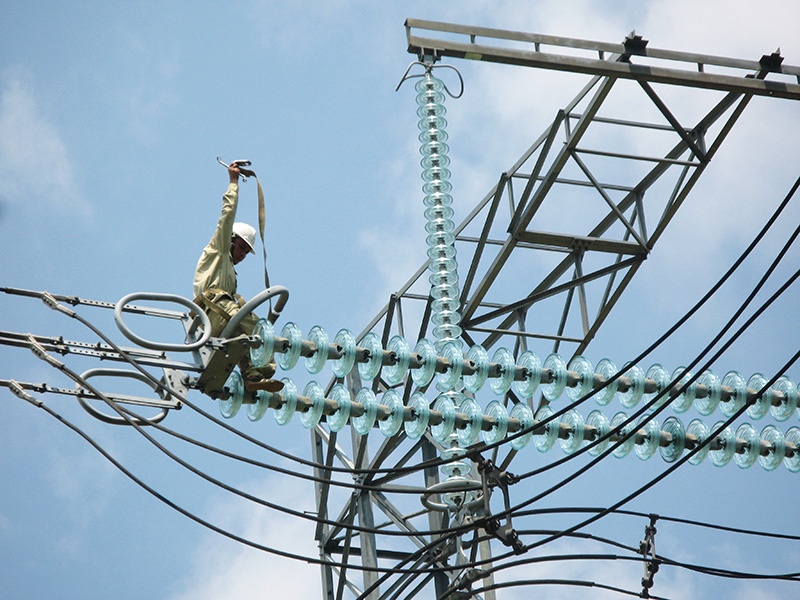Balanced planning in the works for power
 |
| At the end of last year, the total installed capacity exceeded the PDP7’s goal by 10,000MW. Photo: Duc Thanh |
Many power projects in the current plan (PDP) towards 2025 are behind schedule. The Government Office last week announced the conclusion by Deputy Prime Minister Le Van Thanh at the meeting of the National Electricity Development Steering Committee, in which the DPM assigned the Ministry of Industry and Trade (MoIT) to review price mechanisms for all sources of electricity to compete transparently and reduce the purchase price of electricity.
Limited grid investment has been detrimental to renewable energy development. In mid-September, a collective petition of more than 40 businesses that invested in solar power in the Central Highlands province of Gia Lai was sent to the government and related agencies after Electricity of Vietnam (EVN) proposed to reduce investors’ power generation capacity by 50-70 per cent in the last months of 2021.
Reacting to this proposal, investors said that the management of power generation between solar, coal, and hydroelectric sources was not reasonable. They proposed that the MoIT should consider directing EVN and related agencies to develop a plan to exploit the most effective energy sources, while minimising waste and losses of enterprises’ investments in solar power and social capital.
The unbalanced development of solar power due to its rapid growth compared to the national power structure has been leading to technical inadequacies and inefficient exploitation and operation.
While Vietnam is approaching the flood season, EVN is prioritising hydroelectricity as the cheapest source of power generation. In 2020, the favourable rainy season allowed EVN to significantly increase hydropower generation (up 10.2 per cent) compared to 2019, contributing 30 per cent to the total output of the whole system. However, hydroelectricity only accounts for 20.7GW, equivalent to about one-third of the total installed capacity, and remains unstable as some factors are beyond the control of the producers.
While hydroelectricity and other renewable energy sources are gaining traction, the role and dominance of coal and gas-fired power sources in the national power structure will inevitably lead to challenges. The purchase price of electricity from renewable energy sources, such as wind and solar, is higher than of other power sources. Additionally, commercial solar power prices are fixed for 20 years, with prices ranging from 7.09 to 8.38 US cents per kWh, excluding VAT and depending on their installation type.
For wind power projects, those operating before November 1 of this year will enjoy a fixed 20-year purchase price of 9.8 US cents per kWh for offshore farms and 8.5 US cents for onshore ones.
Meanwhile, the purchase price of electricity from coal and hydroelectric power sources ranges from 4.82 to 6.13 US cents per kWh, excluding VAT. Some coal-fired power plants are also offering even lower prices.
Last year, although coal-fired power still played the leading role, accounting for half of the total power output of the system, its share only increased slightly by about 2.5 per cent. EVN now expects that coal-fired power plants will probably record the first decrease in output per year in history this year, which could amount to a 4-per-cent decline despite the resurging power demand.
The PDP7 forecast the total amount of generated electricity to reach 60,000MW by 2020 at the most. However, by the end of last year, the figure sat at nearly 70,000MW.
Dr. Nguyen Xuan Huy from the University of Science and Technology in Ho Chi Minh City said that in order for the proportion of renewables to reach a quarter or more of the total capacity, the scale of the economy must be equivalent to developed countries. “Unbalanced development due to fast growth and overload of the national power structure may lead to technical inadequacies and inefficient exploitation, which may affect development of other power sources and national energy security,” Huy said.
In Thailand, which has similar climatic and agricultural conditions to Vietnam, the total power capacity according to the Thai Ministry of Energy is 46,500MW, roughly equivalent to Vietnam’s total capacity in 2018. Compared with Vietnam, Thailand’s renewable energy development is diversified, uniform, and well-controlled by the government, and that country’s renewables have been developed early.
Vietnam’s planning, according to Huy, should be built in phases based on the objective needs of the country, and shall not be subject to economic pressure and the effects of opportunistic investors. “Vietnam should boldly reduce the proportion of coal-fired power plants and not import outdated equipment, while prioritising gas, wind, and solar development in order to improve efficiency and sustainability,” Huy said.
What the stars mean:
★ Poor ★ ★ Promising ★★★ Good ★★★★ Very good ★★★★★ Exceptional
Related Contents
Latest News
More News
- Driving double-digit growth through green and circular transformation in Vietnam (December 17, 2025 | 09:00)
- Vietnam bucking trend in the global M&A landscape (December 16, 2025 | 14:20)
- Vietnam’s green transition demands collective financial action (December 15, 2025 | 12:00)
- VIR workshop highlights capital and policy for sustainable development (December 15, 2025 | 11:00)
- National Assembly approves pilot mechanisms to accelerate major projects in Hanoi (December 12, 2025 | 11:29)
- Vietnam eases policy approval requirements, simplifies foreign and outbound investments (December 11, 2025 | 17:53)
- Unpacking new momentum in Vietnam’s M&A market (December 10, 2025 | 09:59)
- Forum honours outstanding M&A deals, strategies, and advisory firms (December 09, 2025 | 18:22)
- Vietnam enters defining phase of M&A growth (December 09, 2025 | 17:00)
- Vietnam’s M&A market opens new opportunities amid strong economic momentum (December 09, 2025 | 15:00)

 Tag:
Tag:






















 Mobile Version
Mobile Version